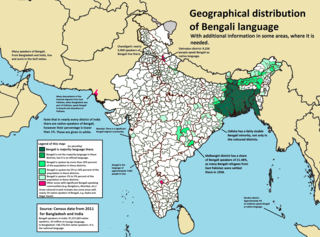Related Research Articles

Modern Standard Hindi, commonly referred to as Hindi, is an Indo-Aryan language spoken chiefly in North India, and serves as the lingua franca of the Hindi Belt region encompassing parts of northern, central, eastern, and western India. Hindi has been described as a standardised and Sanskritised register of the Hindustani language, which itself is based primarily on the Khariboli dialect of Delhi and neighbouring areas of North India. Hindi, written in the Devanagari script, is one of the two official languages of the Government of India, along with English. It is an official language in nine states and three union territories and an additional official language in three other states. Hindi is also one of the 22 scheduled languages of the Republic of India.

Punjabi, sometimes spelled Panjabi, is an Indo-Aryan language native to the Punjab region of Pakistan and India. It is one of the most widely spoken native languages in the world with approximately 113 million native speakers.

Urdu is an Indo-Aryan language spoken chiefly in South Asia. It is the national language and lingua franca of Pakistan, where it is also an official language alongside English. In India, Urdu is an Eighth Schedule language, the status and cultural heritage of which are recognised by the Constitution of India; and it also has an official status in several Indian states. In Nepal, Urdu is a registered regional dialect and in South Africa it is a protected language in the constitution. It is also spoken as a minority language in Afghanistan and Bangladesh, with no official status.

Hindustani is an Indo-Aryan language spoken in Deccan, Northern India and Pakistan, and used as a lingua franca in both countries. Hindustani is a pluricentric language with two standard registers, known as Hindi and Urdu. Thus, it is also called Hindi–Urdu. Colloquial registers of the language fall on a spectrum between these standards. In modern times, a third variety of Hindustani with significant English influences has also appeared which is sometimes called Hinglish or Urdish.

In linguistics, romanization is the conversion of text from a different writing system to the Roman (Latin) script, or a system for doing so. Methods of romanization include transliteration, for representing written text, and transcription, for representing the spoken word, and combinations of both. Transcription methods can be subdivided into phonemic transcription, which records the phonemes or units of semantic meaning in speech, and more strict phonetic transcription, which records speech sounds with precision.

Pakistan is a multilingual country with over 70 languages spoken as first languages. The majority of Pakistan's languages belong to the Indo-Iranian group of the Indo-European language family.
Hinglish is the macaronic hybrid use of South Asian English and the Hindustani language. Its name is a portmanteau of the words Hindi and English. In the context of spoken language, it involves code-switching or translanguaging between these languages whereby they are freely interchanged within a sentence or between sentences.
An anglicism is a word or construction borrowed from English by another language.

Sylheti is an Indo-Aryan language spoken by an estimated 11 million people, primarily in the Sylhet Division of Bangladesh, Barak Valley of Assam, and northern parts of Tripura in India. Besides, there are substantial numbers of Sylheti speakers in the Indian states of Meghalaya, Manipur and Nagaland as well as diaspora communities in the United Kingdom, the United States, Canada and the Middle East.

Pakistani English is the group of English language varieties spoken and written in Pakistan. It was first so recognised and designated in the 1970s and 1980s. Pakistani English (PE), similar and related to British English, is slightly different from other dialects of English in respect to vocabulary, syntax, accent, spellings of some words and other features.
Tanglish refers to the code-mixing or code-switching of the Tamil and English languages, in the context of colloquial spoken language. In the context of colloquial written language, Tanglish refers to the Tamil language written in English alphabet, with extensive usage of English vocabulary.

The Urdu alphabet is the right-to-left alphabet used for writing Urdu. It is a modification of the Persian alphabet, which itself is derived from the Arabic script. It has official status in the republics of Pakistan, India and South Africa. The Urdu alphabet has up to 39 or 40 distinct letters with no distinct letter cases and is typically written in the calligraphic Nastaʿlīq script, whereas Arabic is more commonly written in the Naskh style.
Hindustani has been written in several different scripts. Most Hindi texts are written in the Devanagari script, which is derived from the Brāhmī script of Ancient India. Most Urdu texts are written in the Urdu alphabet, which comes from the Persian alphabet. Hindustani has been written in both scripts. In recent years, the Latin script has been used in these languages for technological or internationalization reasons. Historically, Kaithi script has also been used.
Romanisation of Bengali is the representation of written Bengali language in the Latin script. Various romanisation systems for Bengali are used, most of which do not perfectly represent Bengali pronunciation. While different standards for romanisation have been proposed for Bengali, none has been adopted with the same degree of uniformity as Japanese or Sanskrit.
Tenglish, refers to the code-mixing or code-switching of the Telugu language and Indian English.
Tatsama are Sanskrit loanwords in modern Indo-Aryan languages like Assamese, Bengali, Marathi, Nepali, Odia, Hindi, Gujarati, and Sinhala and in Dravidian languages like Tamil, Kannada and Telugu. They generally belong to a higher and more erudite register than common words, many of which are directly inherited from Old Indo-Aryan (tadbhava). The tatsama register can be compared to the use of loan words of Greek or Latin origin in English.

Bengali, also known by its endonym Bangla, is an Indo-Aryan language native to the Bengal region of South Asia. With approximately 240 million native speakers and another 41 million as second language speakers as of 2021, Bengali is the sixth most spoken native language and the seventh most spoken language by the total number of speakers in the world. It is the fifth most spoken Indo-European language.
Bangladeshi English, is an English accent heavily influenced by the Bengali language and its dialects in Bangladesh. This variety is very common among Bengalis from Bangladesh, and in West Bengal, Assam and Tripura in India to a lesser extent.
References
- 1 2 Coleman, Julie (10 January 2014). Global English Slang: Methodologies and Perspectives. Routledge. p. 130. ISBN 978-1-317-93476-9.
Within India, however, other regional forms exist, all denoting a mixing of English with indigenous languages. Bonglish (derived from the slang term Bong 'a Bengali') or Benglish refers to 'a mixture of Bengali and English', Gunglish or Gujlish 'Gujarati + English', Kanglish 'Kannada + English', Manglish 'Malayalam + English', Marlish 'Marathi + English', Tamlish or Tanglish 'Tamil + English' and Urdish 'Urdu + English'. These terms are found in texts on regional variations of Indian English, usually in complaint-tradition discussions of failing standards of language purity.
- ↑ Lambert, James. 2018. A multitude of ‘lishes’: The nomenclature of hybridity. English World-wide, 39(1): 32. DOI: 10.1075/eww.38.3.04lam
- ↑ "Learning In 'Urdish'". Archived from the original on 17 November 2015. Retrieved 10 October 2015.
- ↑ Yousafzai, Fawad. "Govt to launch 'Ilm Pakistan' on August 14: Ahsan". Archived from the original on 17 November 2015. Retrieved 10 October 2015.
- ↑ Mustafa, Zubeida. "Over to 'Urdish'". Archived from the original on 17 October 2015. Retrieved 10 October 2015.